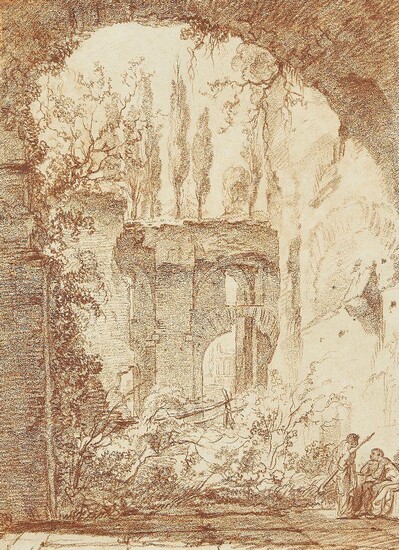Attributed to Jean-Simon Berthélemy, French 1743-1811- The Temple of Sibyl, Tivoli, seen through an Arch from the Villa Maecenas, 1774; red chalk on paper, 52.4 x 38.4 cm. Provenance: Curwen Eliot Hodgkin (1905-1987) and Maria (Mimi) Clara...
Attributed to Jean-Simon Berthélemy,
French 1743-1811-
The Temple of Sibyl, Tivoli,seen through an Arch from the Villa Maecenas, 1774;
red chalk on paper, 52.4 x 38.4 cm.
Provenance: Curwen Eliot Hodgkin (1905-1987) and Maria (Mimi) Clara Henderson Hodgkin, London.; With Artemis Ltd, London (as Hubert Robert), 1995.; With Denenberg Fine Arts, Inc., San Francisco and West Hollywood, California.; Anon. sale, Bonhams Knightsbridge, 25
Oct. 2017, lot 282.; Private Collection, UK.
Exhibited: London, Royal Academy of Arts, 'France in the Eighteenth Century', Winter Exhibition, 6 January-3 March 1968, no.599 (as Hubert Robert, Landscape with ruins).
Literature: Exh. cat., 'France in the 18th Century', D. Sutton (ed.), London, Royal Academy of Arts, Winter Exhibition, 1968, p.113, no.599 (as Hubert Robert, Landscape with ruins).
Note: Berthélemy trained under Noël Hallé (1711-81) and won the Prix de Rome in 1769 with his painting ‘Alexander cutting the Gordian Knot’. The French, unlike most British artists in the eighteenth century who visited Rome under somewhat haphazard circumstances, enjoyed a formal system by which successful candidates in the annual ‘Prix de Rome’ painting competition then undertook a three-year study period in Rome, as ‘pensionnaires’ of the King at the ‘Académie de France’. Berthélemy was a prize winner in 1769 and arrived in Italy at the end of 1770. On the advice of the Director of the ‘Académie’, Charles-Joseph Natoire, and influenced by the landscapes of Hubert Robert and Jean-Honoré Fragonard, he began to devote himself to landscape drawing, a practice not normally accorded importance in academic training. In this he was encouraged by Joseph-Benoît Suvée and Pierre-Adrien Pâris, who in the summer of 1774 took him to the ‘Villa d’Este’ at Tivoli, an experience that was to have a lasting effect on his artistic development. His red chalk drawings, taken here in 1774, towards the end of his visit to Italy, mark a break with the literal realism of the traditional topographical view, and encompass both the direct observation of nature as well as elements of picturesque romanticism.
In size, technique and style, the present work belongs to these group of views of the ‘Villa d’Este’ and its environs. The focus of Berthélemy’s attention in this drawing was clearly not so much his slightly sketched figures, included, no doubt, to introduce scale, but on the great overgrown ruins which constitute the main feature of the composition. A number of spectacular large drawings confidently executed in red chalk, such as those of the ‘Villa d’Este’ (Museé des Beaux-Arts, Orléans, no.727), the ‘Villa Colonna’ and ‘Villa Negroni’ (Museé des Beaux-Arts & Histoire Nationale, Valence), can be compared on stylistic grounds to the present work.
View it on
Estimate
Reserve
Time, Location
Auction House
Attributed to Jean-Simon Berthélemy,
French 1743-1811-
The Temple of Sibyl, Tivoli,seen through an Arch from the Villa Maecenas, 1774;
red chalk on paper, 52.4 x 38.4 cm.
Provenance: Curwen Eliot Hodgkin (1905-1987) and Maria (Mimi) Clara Henderson Hodgkin, London.; With Artemis Ltd, London (as Hubert Robert), 1995.; With Denenberg Fine Arts, Inc., San Francisco and West Hollywood, California.; Anon. sale, Bonhams Knightsbridge, 25
Oct. 2017, lot 282.; Private Collection, UK.
Exhibited: London, Royal Academy of Arts, 'France in the Eighteenth Century', Winter Exhibition, 6 January-3 March 1968, no.599 (as Hubert Robert, Landscape with ruins).
Literature: Exh. cat., 'France in the 18th Century', D. Sutton (ed.), London, Royal Academy of Arts, Winter Exhibition, 1968, p.113, no.599 (as Hubert Robert, Landscape with ruins).
Note: Berthélemy trained under Noël Hallé (1711-81) and won the Prix de Rome in 1769 with his painting ‘Alexander cutting the Gordian Knot’. The French, unlike most British artists in the eighteenth century who visited Rome under somewhat haphazard circumstances, enjoyed a formal system by which successful candidates in the annual ‘Prix de Rome’ painting competition then undertook a three-year study period in Rome, as ‘pensionnaires’ of the King at the ‘Académie de France’. Berthélemy was a prize winner in 1769 and arrived in Italy at the end of 1770. On the advice of the Director of the ‘Académie’, Charles-Joseph Natoire, and influenced by the landscapes of Hubert Robert and Jean-Honoré Fragonard, he began to devote himself to landscape drawing, a practice not normally accorded importance in academic training. In this he was encouraged by Joseph-Benoît Suvée and Pierre-Adrien Pâris, who in the summer of 1774 took him to the ‘Villa d’Este’ at Tivoli, an experience that was to have a lasting effect on his artistic development. His red chalk drawings, taken here in 1774, towards the end of his visit to Italy, mark a break with the literal realism of the traditional topographical view, and encompass both the direct observation of nature as well as elements of picturesque romanticism.
In size, technique and style, the present work belongs to these group of views of the ‘Villa d’Este’ and its environs. The focus of Berthélemy’s attention in this drawing was clearly not so much his slightly sketched figures, included, no doubt, to introduce scale, but on the great overgrown ruins which constitute the main feature of the composition. A number of spectacular large drawings confidently executed in red chalk, such as those of the ‘Villa d’Este’ (Museé des Beaux-Arts, Orléans, no.727), the ‘Villa Colonna’ and ‘Villa Negroni’ (Museé des Beaux-Arts & Histoire Nationale, Valence), can be compared on stylistic grounds to the present work.



